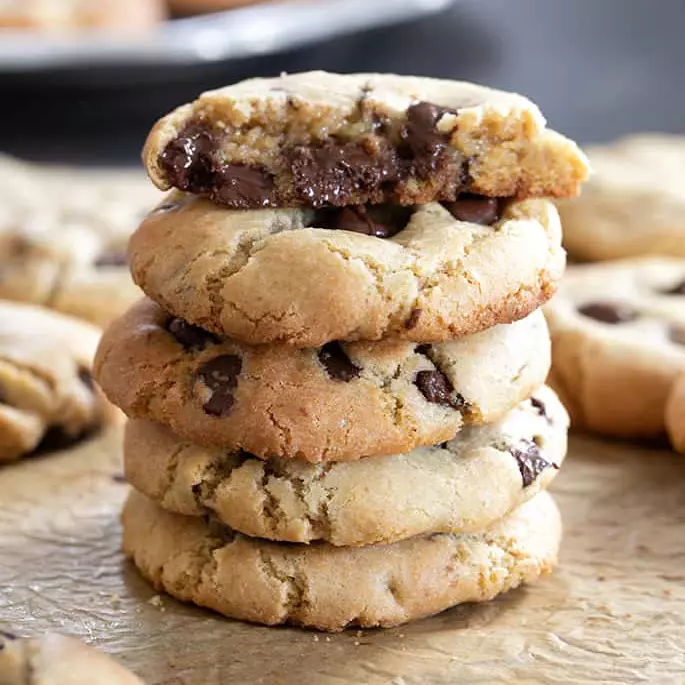

These classic gluten free chocolate chip cookies are deliciously rich and thick, with slightly crisp brown edges and the perfect chewy center. They really are the best you'll find!
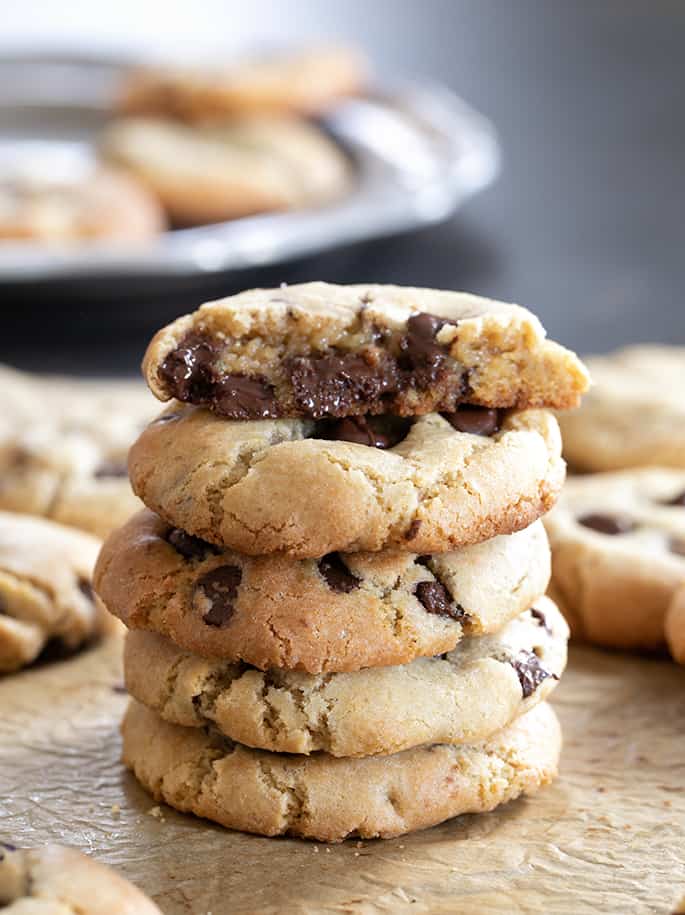
What makes these “the best” gluten free chocolate chip cookies?
It's entirely possible that you already have a recipe for classic gluten free chocolate chip cookies that you think is straight-up the best. But I'm here to tell you, these are better.
This recipe is a version of the thick and chewy chocolate chip cookies that I was small-f famous for, long before I started baking gluten free for my son (and you) in 2004. In fact, I'd been making them for years before that.
What makes them stand out from the cookie-filled crowd? They still brown. They hold the same glorious shape. They're thick, and they are chewy.
They're ever so slightly crisp on the very edges and the bottom, but just enough that they are ridiculously satisfying to bite into. This is the super simple chocolate chip drop cookie recipe that is simply perfect for so many occasions.
They’re so easy to make you can whip them up for a last-minute bake sale, serve them for dessert with some gluten free no churn vanilla ice cream, or make them ahead of time and freeze them until you have a sweet tooth emergency. If you prefer a cookie that isn't crispy on the edges, thick throughout, and chewy in the cente –one that bakes up thin and chewy–try our recipe for soft and chewy gluten free chocolate chip cookies.
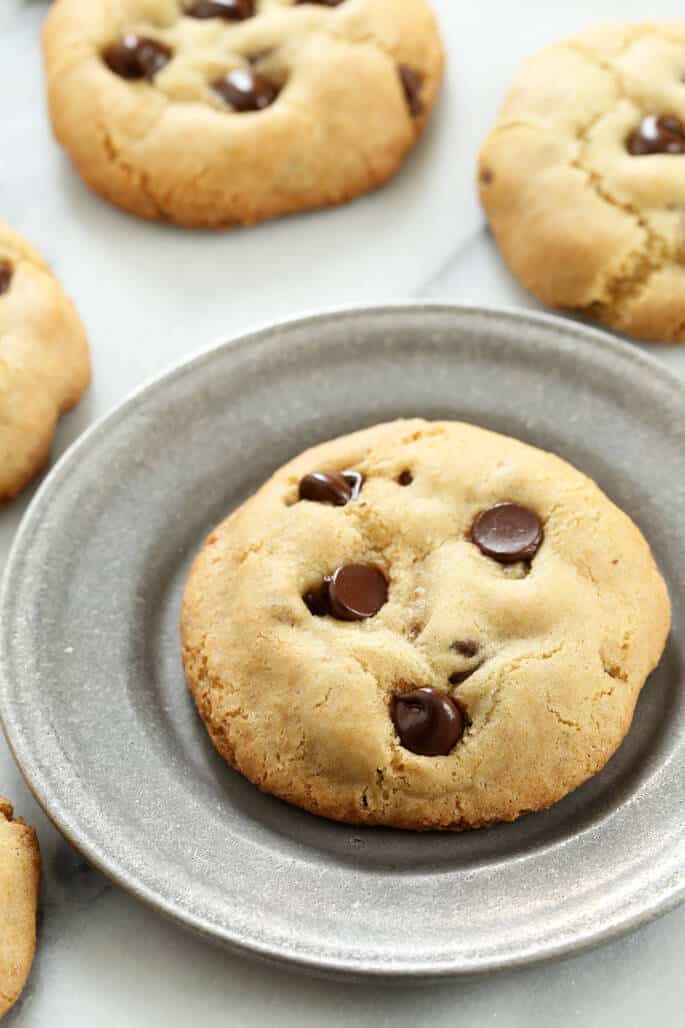
Tips for baking thick and chewy gluten free chocolate chip cookies
This recipe for gluten free chocolate chip cookies is incredibly easy. And it's fairly forgiving, too, making it perfect for beginner gluten free bakers as well as seasoned baking pros. But no matter your experience, there are some tips and tricks that can help you make these gluten free cookies bake perfectly and last longer.
Can you freeze the raw cookie dough?
Both the shaped dough and the cookies themselves freeze perfectly. I almost always have a batch of the cookies themselves, and a batch of the cookie dough disks in my freezer.
You can bake them right from frozen, but if you plan to do that, I recommend pressing the raw disks of cookie dough flatter, since they'll spread less if you bake them from frozen. You'll also need to add another minute or two to the baking time.
Do you have to chill the gluten free cookie dough?
If your cookie dough is at room temperature to begin with, you will only need to chill the shaped dough for a few minutes before baking. It will maintain its shape during baking, crackling a bit toward the end of baking.
If you live in a hot and/or humid climate, chilling the shaped cookie dough becomes more important. The best way to know how important chilling the dough will be is if your “room temperature” butter is nearly liquefied.
If you press your finger lightly into the butter, and it leaves a shallow impression, your butter is at perfect room temperature. If the butter barely resists your touch, your butter is too soft.
Your cookie dough may end up a bit greasy, so be sure you're mixing it a bit extra (ideally in a stand mixer) and then chilling it until firm after shaping. For more tips on making gluten free cookies of all kinds, see our tips and tricks for making gluten free cookies.
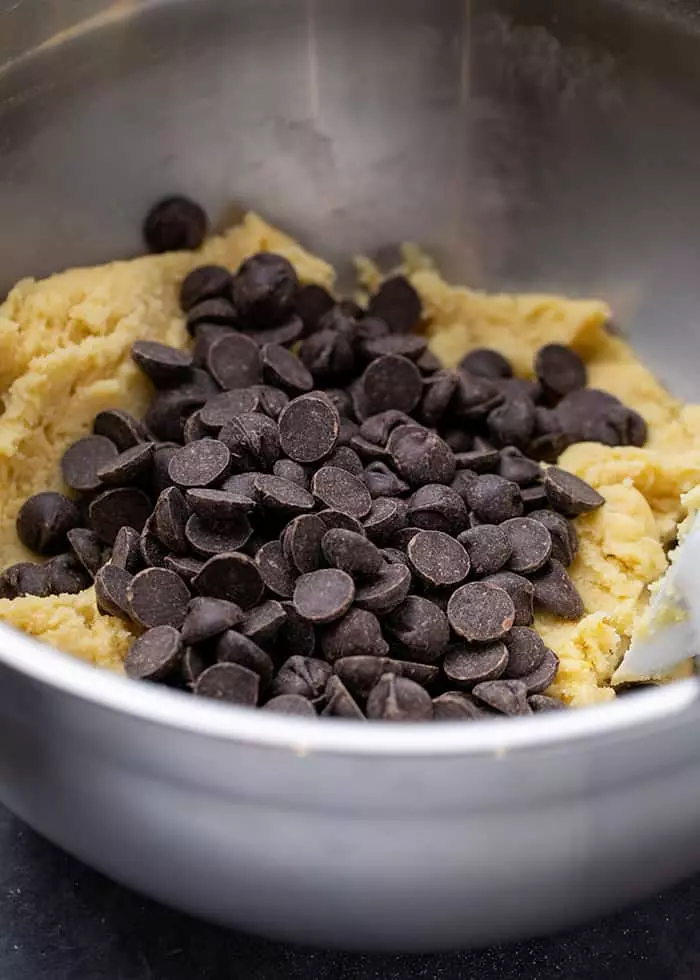
How many chocolate chips should you add?
You'll notice that there is actually a range of chocolate chips that you can add to this recipe. You begin with 12 ounces of semi-sweet chocolate chips, and you can add up to another 4 ounces for a total of 16 ounces, or 1 full pound.
It's really a matter of personal taste (how many chips are you hoping for in each and every bite?). But, be aware that if you add more than about 14 ounces of chips, the cookies will be less likely to keep their perfect shape during baking.
Mix all the dry ingredients first
It's important that you whisk all the dry ingredients, apart from the brown sugar, together first, just like the recipe tells you. This way, the dry ingredients are properly and consistently incorporated throughout the cookie dough.
If you try and make gluten free chocolate chip cookies by just throwing everything in a bowl altogether, you'll find that your cookies won't be consistent. You will most likely experience problems like excessive spreading, no rise, or clumps of improperly blended dry ingredients.
Save yourself the headache and take the extra 30 seconds to blend the dry ingredients before you add the brown sugar and the wet ingredients. Once you've added the brown sugar, be sure to break up any lumps in it before adding the butter, eggs, and vanilla.
Mix the wet ingredients into the dry ingredients
We make this cookie dough using the “reverse cream method,” which means that we add the wet ingredients into the dry instead of creaming the butter first. Why do we do it this way around? Creaming the butter first would incorporate air into the cookie dough. Using the reverse cream method avoids adding air into the cookie dough, and allows us to make the chewiest, most deliciously dense gf chocolate chip cookies. Gf cookies should taste like cookies, not gf cake (all due respect to gluten free cake!).
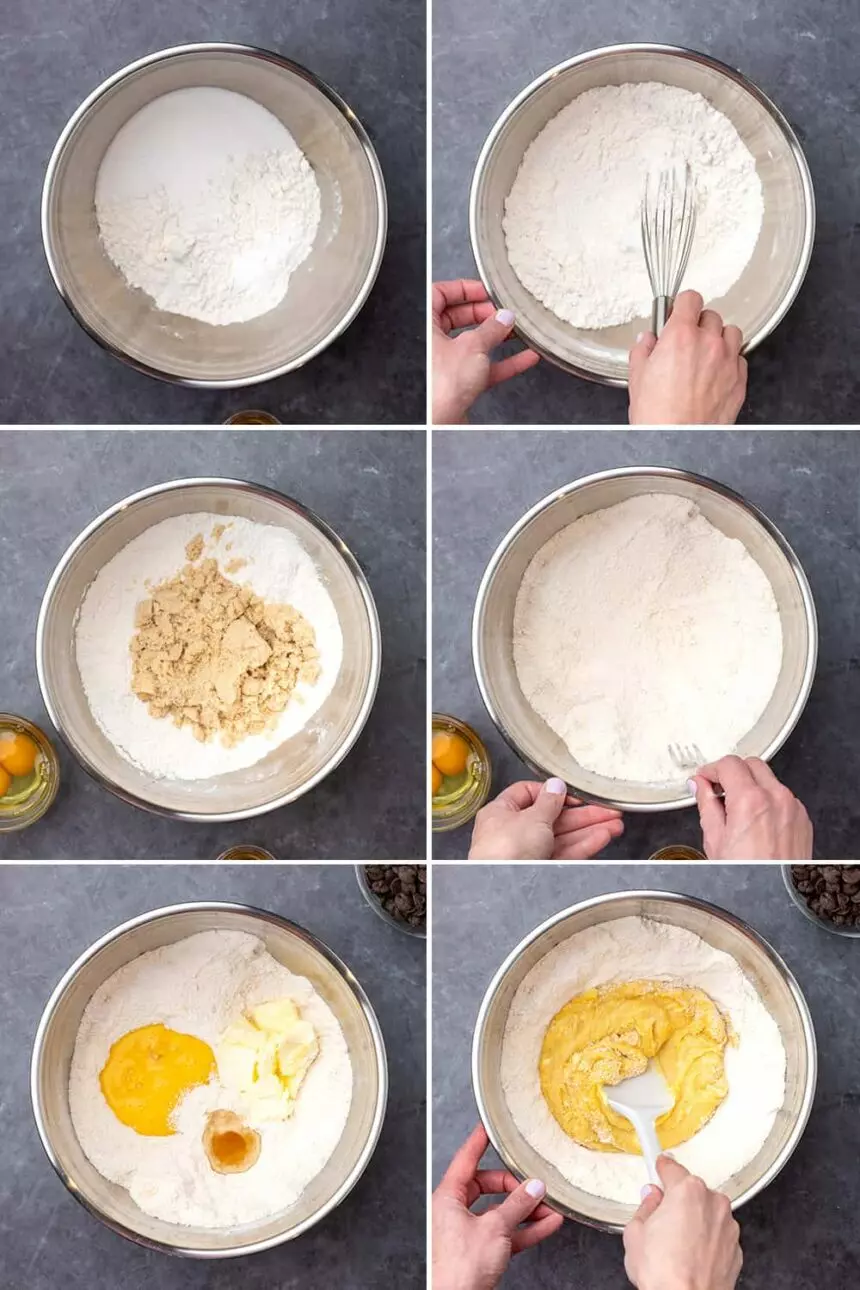
Use a silicone spatula to press the wet ingredients into the dry ingredients
In this recipe, when you're mixing the eggs, butter, and vanilla into the dry ingredients in the cookie dough, begin by mixing the wet ingredients together in the center, and then draw the dry ingredients into the wet by pressing the back of a silicone spatula firmly into the wet ingredients. It will hydrate the dry ingredients more slowly, making it easier to create a smooth, uniform gf cookie dough. Remember, we want to keep our cookie dough as consistent as possible so each bite will be perfectly chewy and delicious!
Add a few more chocolate chips
If you're rolling your cookie dough, and you feel like you just can't see enough chocolate chips, go ahead and add a few more to each of the cookie dough balls. The number of chocolate chips you add is up to you, but don’t forget that the more densely packed your dough is with chips, the less likely it will keep its perfect shape.
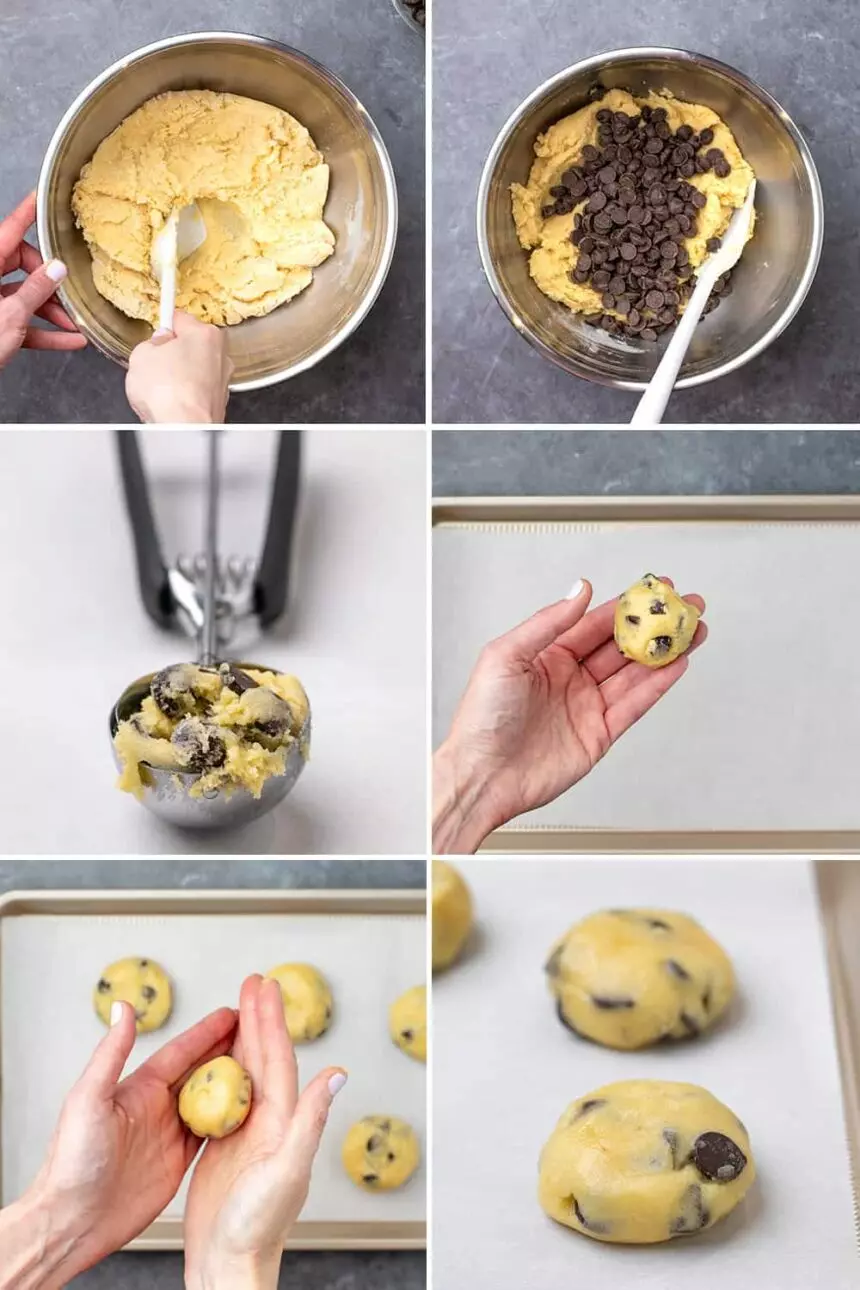
Chill the cookie dough for at least 12 hours
I know this is not what anyone wants to hear, because this is a simple recipe that should produce quick, easy, delicious home-baked gf cookies in minutes! If you want your cookies to stay thick, you'll need to chill them at least until they're cold.
And if you want the cookies to have that beautiful caramel flavor that the best chocolate chip cookies have, you'll need to chill them for at least 12 hours. You might be craving a chocolate chip cookie right now, but trust me, this step makes all the difference!
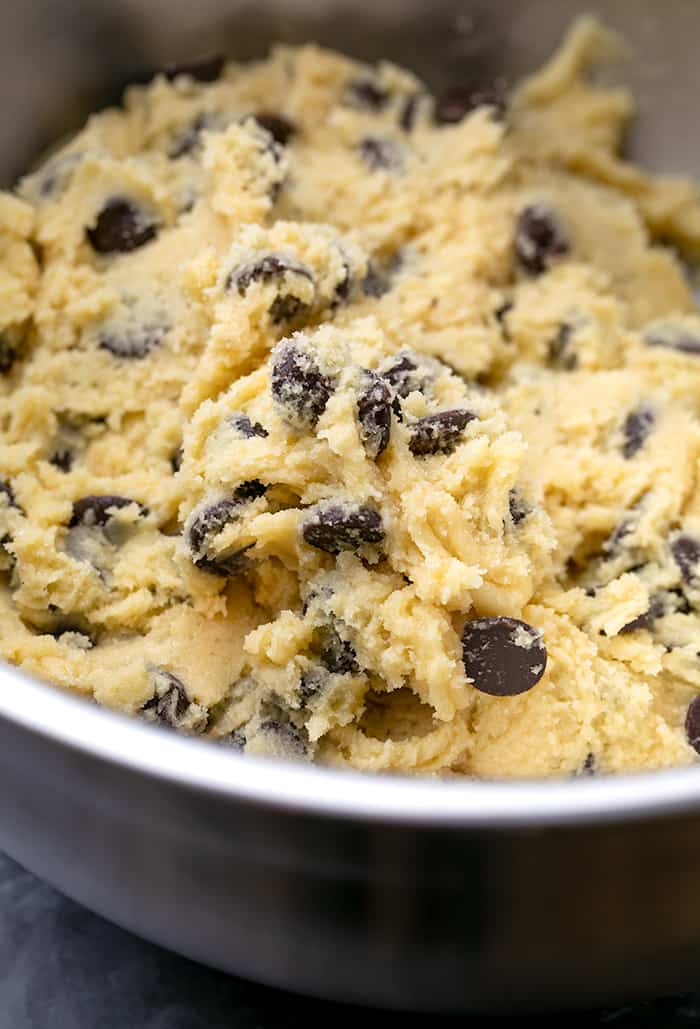
Substitutions for gluten free chocolate chip cookies ingredients
This recipe for gluten free chocolate chip cookies is easy—and it's pretty forgiving. So you can make some substitutions and still get really great, tasty gluten free cookies. But please be cautious, particularly if you've never made them before.
Gluten free dairy free chocolate chip cookies
I have successfully made this recipe with Spectrum healthy vegetable shortening (an affiliate link) in place of butter, and they come out beautifully. They don't brown as much in the oven, but they're still crisp on the edges. Keep in mind that shortening will get very hard in the refrigerator, so be sure to shape the dough before chilling it or you won't be able to shape it at all.
Avoid using vegan spreads as, like margarine, these will cause your gluten free chocolate chip cookies to spread excessively during the bake.
You can also try using Melt or Miyoko's Kitchen brand vegan butter. Those are generally my favorite butter substitutes for baking process. No amount of chilling will save your cookie’s perfectly round shape!.
Gluten free egg free chocolate chip cookies
You can try replacing the two eggs in this recipe with a “chia egg” each (1 tablespoon ground white chia seeds + 1 tablespoon lukewarm water, mixed and allowed to gel).
These are such simple cookies that the texture may not be the same when you make such an important substitution, but it's definitely worth trying. If you do try this method, let us know how it worked in the comments section below!
If you'd like to make a recipe that is written to be dairy-free and egg-free, try our vegan gluten free chocolate chip cookies recipe.
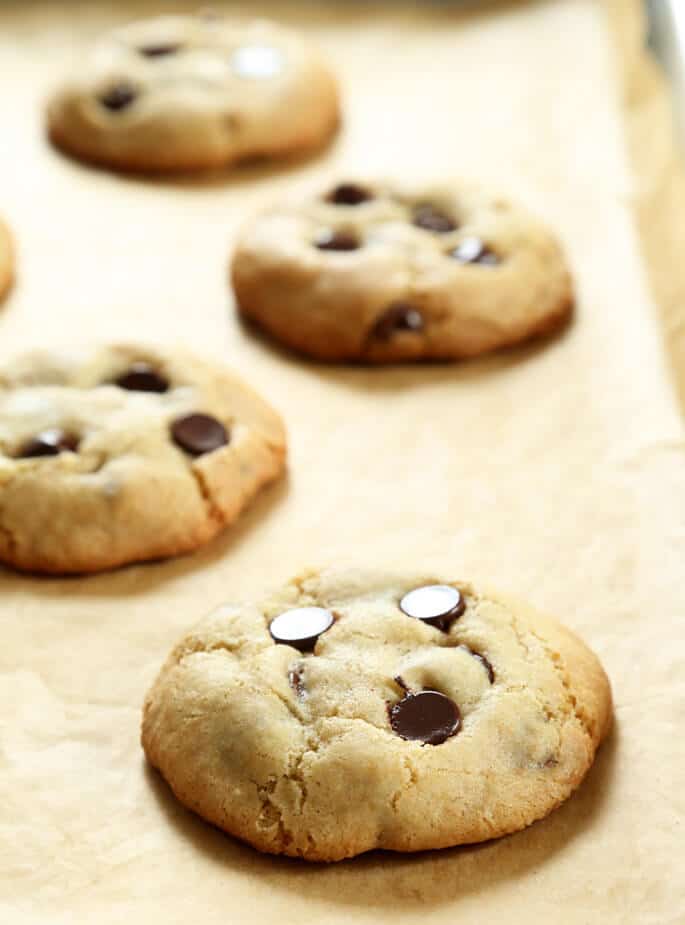
FAQs
Both the shaped dough and the cookies themselves freeze perfectly. I almost always have a batch of the cookies themselves and a batch of the cookie dough disks in my freezer.
You can bake them right from frozen, but if you plan to do that, I recommend pressing the raw disks of cookie dough flatter since they'll spread less if you bake them from frozen. You'll also need to add another minute or two to the baking time.
If your cookie dough is at room temperature to begin with, you will only need to chill the shaped dough for a few minutes before baking. It will maintain its shape during baking, crackling a bit toward the end of baking.
If you live in a hot and/or humid climate, chilling the shaped cookie dough becomes more important. The best way to know how important chilling the dough will be is if your “room temperature” butter is nearly liquefied.
If you press your finger lightly into the butter, and it leaves a shallow impression, your butter is at perfect room temperature. If the butter barely resists your touch, your butter is too soft.Your cookie dough may end up a bit greasy, so be sure you're mixing it a bit extra (ideally in a stand mixer) and then chilling it until firm after shaping. For more tips on making gluten free cookies of all kinds, see our tips and tricks for making gluten free cookies.
If you don't want to freeze the cookies, I recommend wrapping them tightly or placing them in an airtight container. From there I recommend keeping them in the refrigerator for up to 5 days. Although I doubt they'll hang around that long, as they're just so good!
Let’s be honest, these are not healthy cookies. They're gluten free chocolate chip cookies, and they’re meant to have all the good stuff: butter, sugar, eggs, vanilla. But you might be able to make them with a sugar substitute.
If you would like to try them with a sugar substitute, I recommend Lankato brand monk fruit granulated sugar replacement for the granulated sugar and their “golden” variety as a replacement for the brown sugar. You can also replace the brown sugar with coconut sugar one-for-one.
Those sugar alternatives do tend to be drying, though, so you may need to add water by the half-teaspoonful as necessary to achieve the proper cookie dough consistency. Watch the video carefully before trying the swap.
The best gluten free flour for these chocolate chip cookies is a high-quality gluten free flour blend. I've used Better Batter here, but you can also use my Better Than Cup4Cup blend if you prefer to make your own.
Just be sure to avoid anything that's too grainy and coarse or that tends to be inconsistent. Check out my gluten free flour guide for more detail.
There are several reasons why your gluten free chocolate chip cookies might be dry and crumbly:
1. You didn't let them cool and firm on the baking sheet for long enough after baking.
2. You didn't use enough xanthan gum, or any at all.
3. You used a poor-quality all purpose gluten free flour blend that uses gritty rice flour and/or is just poorly balanced so nothing you make with it will turn out as intended.
4. Your butter was too cold when you made the cookie dough, so it never got fully mixed into the cookie dough, leaving it in big pockets here and there. Next time, refer to our “finger in the butter” test above to check that yours is at the right temperature.
5. You got a measurement wrong so the cookies had too much gf flour.
If your gluten free chocolate chip cookies are flat, it could be because the butter was melted or just too greasy when you made the cookie dough, or your cookie dough was too warm for another reason when you put your batch in the oven. Remember, your cookie dough must be at least cold before it goes in the oven or the fat will melt too quickly, leading to flat cookies. So, don’t forget how the warmth of your kitchen can affect the final result of your cookies.
I get the best results with xanthan gum, but if you're really set on baking gluten free chocolate chip cookies, or really any gluten free recipes without it, here are some potential alternatives:
– Ground psyllium husk (note that I do not like the taste or texture that this ingredient adds to baked goods, but some have had success with it)
– Guar gum (although it's better in cold applications; xanthan gum is better for heated recipes, like this one)
– Konjac powder (this is by far the most promising xanthan gum substitute)
Yes, the 12 ounces of chocolate chips called for in the recipe is about 2 cups in volume. So if you reduce the chips by ½ a cup, you can add ½ a cup of nuts. What type of nuts you add is up to you, but I think the following nuts would work best here:
– Pecans
– Walnuts
– Hazelnuts
– Almonds
– Macadamia nuts
Or a mix of a few! Roughly chop the nuts to a similar size as the chocolate chips (but not too small!) before adding them to the cookie dough.
Depending on which type of dried fruit you want to add to your cookies, replace a quarter of the measurement for the chocolate chips with dried fruit. I don’t recommend harder dried fruit like banana, peach or apricot but berries would work well here. Cranberries, goji berries or raisins are probably the best substitutions.
When choosing your dried fruit, read the packaging carefully to make sure it is entirely gluten free and hasn’t been processed with gluten or exposed to gluten in any way.
Ok, I feel semi-sweet chocolate chips are the best option for these cookies – that gooey rich melting flavor as you bite into the chocolate gets me every time. But if your taste buds lean towards something sweeter, or something less sweet, then, by all means, make the cookie work for you!
Use milk chocolate chips for a lighter sweeter result, or if you can find dark chocolate chips, they’ll give you a much stronger flavor. Alternatively, go for a combination of some or all the chocolate chips – we can’t have enough chocolate!
These days most chocolate chips are gluten free, but check the packaging just to make sure.
Gluten Free Chocolate Chip Cookies
Ingredients
- 2 ¼ cups (315 g) all purpose gluten free flour blend (I use Better Batter, but my Better Than Cup4Cup blend works well, too)
- 1 teaspoon xanthan gum omit if your flour blend already contains it
- ½ teaspoon kosher salt
- 1 teaspoon baking soda
- ¾ cup (150 g) granulated sugar
- ¾ cup (164 g) packed light brown sugar
- 8 tablespoons (112 g) unsalted butter at cool room temperature
- 2 (100 g (weighed out of shell)) eggs at room temperature, beaten
- 1 tablespoon pure vanilla extract
- 12 ounces semisweet chocolate chips plus more as desired, up to 16 ounces total
Instructions
- Preheat your oven to 350°F about 15 minutes before you plan to bake your cookies. Line rimmed baking sheets with unbleached parchment paper and set them aside.
- In a large bowl, place the flour, xanthan gum, salt, baking soda and granulated sugar, and whisk to combine well.
- Add the brown sugar, and whisk again to combine, working out any lumps in the brown sugar. If you are finding many lumps, try using the tines of a fork to break up any stubborn ones.
- Create a well in the center of the dry ingredients, and add the butter, eggs, and vanilla, and mix until well-combined.
- You can use a stand mixer fitted with the paddle attachment to make quick work of it.
- Add 12 ounces of chocolate chips and mix until evenly distributed throughout the cookie dough. The cookie dough will be thick but not stiff. Add more chocolate chips if you like, and mix thoroughly.
- Divide the cookie dough into 21 portions (or 24 if you’ve used all 16 ounces of chips), and roll each tightly into a ball about 1 1/2 inches in diameter (and about 50 grams each).
- Press each of the balls of dough into a disk about 1/2-inch thick and place about 2 inches apart on the prepared baking sheets.
- As you’re rolling the dough, add a few more chocolate chips to each ball, if desired, and roll them into the dough.
- To ensure the thickest cookies with the best flavor and color, cover the dough on the baking sheet and refrigerate the shaped cookie dough for at least 12 hours and up to 5 days.
- Remove the chilled dough from the refrigerator and place the baking sheets, one at a time, in the center of the preheated oven.
- Bake until the cookies are golden brown around the edges, light golden brown all over and set in the center (about 12 minutes).
- Remove from the oven and allow the cookies to cool on the baking sheet for about 5 minutes or until firm before transferring to a wire rack to cool completely.
Notes
Nutrition
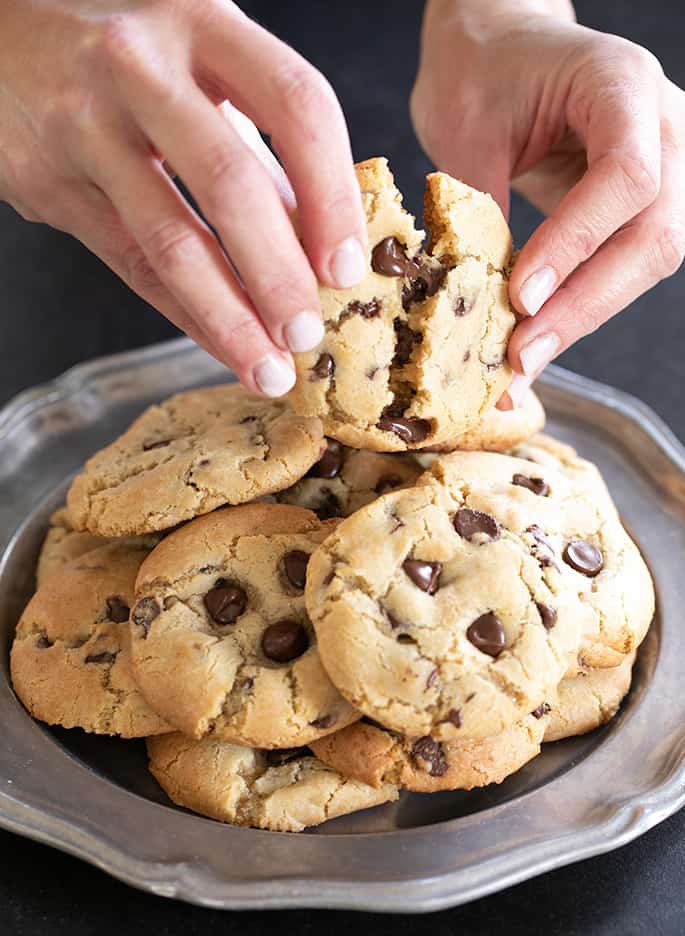
Gluten Free Chocolate Chip Cookies
Ingredients
- 2 ¼ cups (315 g) all purpose gluten free flour blend (I use Better Batter, but my Better Than Cup4Cup blend works well, too)
- 1 teaspoon xanthan gum omit if your flour blend already contains it
- ½ teaspoon kosher salt
- 1 teaspoon baking soda
- ¾ cup (150 g) granulated sugar
- ¾ cup (164 g) packed light brown sugar
- 8 tablespoons (112 g) unsalted butter at cool room temperature
- 2 (100 g (weighed out of shell)) eggs at room temperature, beaten
- 1 tablespoon pure vanilla extract
- 12 ounces semisweet chocolate chips plus more as desired, up to 16 ounces total
Instructions
- Preheat your oven to 350°F about 15 minutes before you plan to bake your cookies. Line rimmed baking sheets with unbleached parchment paper and set them aside.
- In a large bowl, place the flour, xanthan gum, salt, baking soda and granulated sugar, and whisk to combine well.
- Add the brown sugar, and whisk again to combine, working out any lumps in the brown sugar. If you are finding many lumps, try using the tines of a fork to break up any stubborn ones.
- Create a well in the center of the dry ingredients, and add the butter, eggs, and vanilla, and mix until well-combined.
- You can use a stand mixer fitted with the paddle attachment to make quick work of it.
- Add 12 ounces of chocolate chips and mix until evenly distributed throughout the cookie dough. The cookie dough will be thick but not stiff. Add more chocolate chips if you like, and mix thoroughly.
- Divide the cookie dough into 21 portions (or 24 if you’ve used all 16 ounces of chips), and roll each tightly into a ball about 1 1/2 inches in diameter (and about 50 grams each).
- Press each of the balls of dough into a disk about 1/2-inch thick and place about 2 inches apart on the prepared baking sheets.
- As you’re rolling the dough, add a few more chocolate chips to each ball, if desired, and roll them into the dough.
- To ensure the thickest cookies with the best flavor and color, cover the dough on the baking sheet and refrigerate the shaped cookie dough for at least 12 hours and up to 5 days.
- Remove the chilled dough from the refrigerator and place the baking sheets, one at a time, in the center of the preheated oven.
- Bake until the cookies are golden brown around the edges, light golden brown all over and set in the center (about 12 minutes).
- Remove from the oven and allow the cookies to cool on the baking sheet for about 5 minutes or until firm before transferring to a wire rack to cool completely.
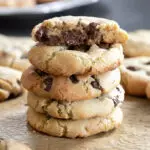
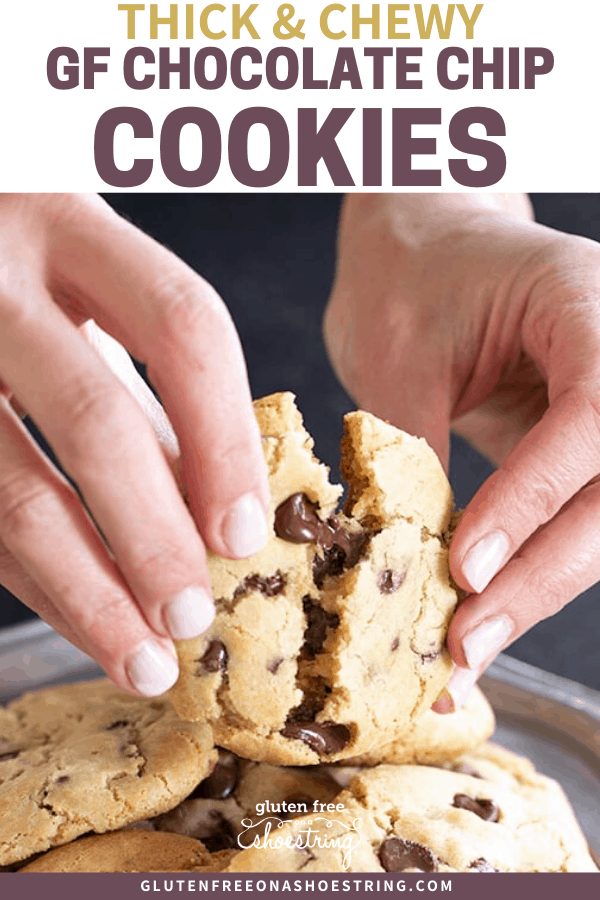
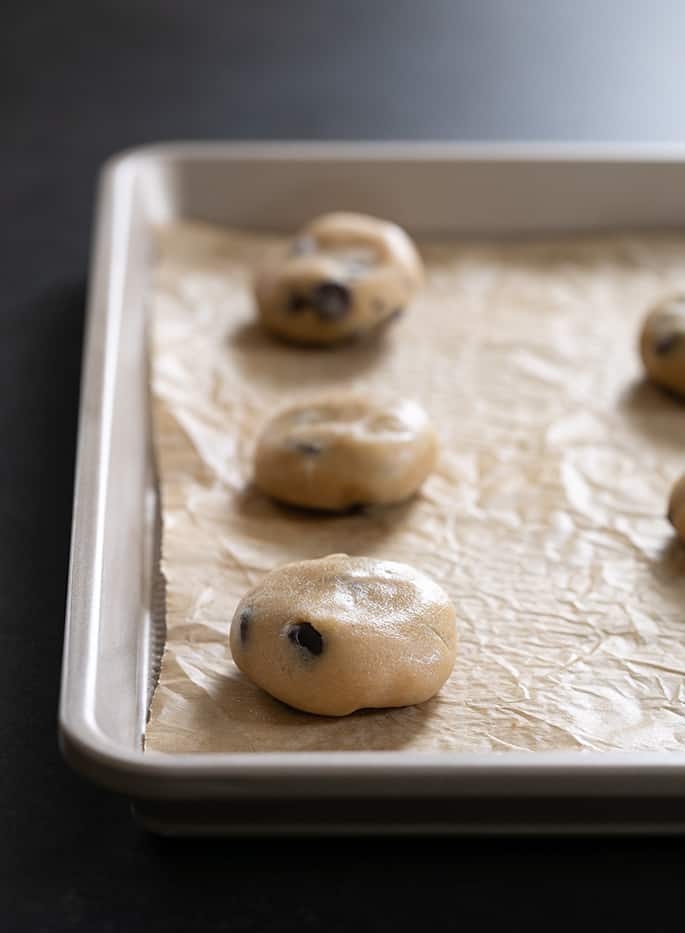

Halima says
Hi I’m looking for the previous recipe you had for oat flour chocolate chip cookies. Any chance you can share that recipe with me. It was soooo perfect.
Thank you
Nicole Hunn says
You can always use the search function to find whatever recipe you’re seeking, Halima. Here’s a link to the oat flour chocolate chip cookies.
Kristin Evans says
I stumbled across your page, bought your multipurpose flour and xanthum gum powder after learning you cannot just substitute gluten free flour in recipes. I had previously been using the cup 4 cup with no success. Honestly had little hope for the cookies, but was amazed how they came out! 10/10 stars! I followed your directions except used my mixer and refrigerated for 24 hours. These cookies are incredible! Thank you!
Nicole Hunn says
That’s so great to hear, Kristin! It’s a hard pill to swallow that there’s no such thing as a literal “cup for cup” replacement for wheat flour in conventional recipes, but there’s light at the end of the tunnel. Thank you for sharing your experience.
Nana Ria says
Fabulous recipe!! My granddaughters love these, say they don’t taste gluten free!
Nicole Hunn says
That’s so great to hear. Thanks for sharing your experience, Nana Ria. Those are some lucky grandkids. :)
Sue says
I used the Cup4Cup flour for this recipe and followed the directions. They turned out well, with a cooking time adjustment.
Mady says
These cookies were great! I still had to find my self controll in my over-stuffed brain because I was eating way too many cookies. 🤫 But the’re amazing. Do you have any more recipes on different breakfest meals?
Nicole Hunn says
Yes, Mandy, there are many breakfast recipes on the blog. Please use the search function to find whatever you’re looking for. So glad you enjoyed the cookies, and I think there’s no such thing as “too many cookies.” 😉
DW says
Can I use regular salt in place of kosher salt?
Nicole Hunn says
Kosher salt is commonly used in baking since it’s harder to overmeasure. Table salt is more dense than kosher salt, so for each teaspoon of kosher salt, you’d need to use about 1/4 teaspoon less table salt. Here, you can try just using a scant 1/2 teaspoon, instead of a full one. I haven’t tried this conversion though so you’ll have to experiment.
Ally says
Delicious and quick recipe! I literally ate 5 cookies🤫
Nicole Hunn says
So glad to hear it, Ally! It’s not your fault. These are the indeed the best cookies.🙃
Tim says
I want to bake cookies for my gluten free wife.
Stefanie says
Can I use dairy free butter for majority of your recipes if I’m allergic to dairy? Or will this change the taste and consistency of most recipes? Thanks so much!
Nicole Hunn says
I’m afraid that question has to be answered on a case by case basis. Please see the substitutions section of each individual post for my opinion on each recipe.
Susan DiBartolomeo says
These cookies turned out awesome! Delicious and chewy!
Cooling them for 12 hours before baking, is advice well given, 👍
Nicole Hunn says
I’m so glad, Susan. Chilling the dough makes for the best texture and flavor. Thanks for sharing your experience!
Lindsey D. says
These are delicious and by far the most beautiful cookies I’ve made. They look like they came from a bakery! Thank you for this recipe and all of the others you’ve created!!
Nicole Hunn says
That’s so great to hear, Lindsey! There’s something really special about a perfect chocolate chip cookie. Thank you for sharing that.
Sue says
Can you use regular salted butter as opposed to unsalted?
Nicole Hunn says
Yes, you can and just eliminate the salt as an ingredient. The cookies may taste salty though depending on how much salt is in your butter, which you can’t control unless you use unsalted butter (and why baking recipes usually call for unsalted butter).
Nancy says
Chewy!
Erica says
Hey there! First round in the oven now. Fingers crossed. The rest are in the fridge. I was confused at the directions though as at the beginning you say to preheat the oven, then at the end you say to refrigerate the dough for several hours before baking. Thank you for always posting user friendly recipes! I have used to many and have almost always had success!
Nicole Hunn says
Refrigerating the dough is an optional component of the recipe to ensure the best flavor and color. I’ve added some text to clarify that you preheat your oven before you plan to bake the cookie. Hope that helps!
Mollie says
Delicious cookies the first time around, second time making them I did 8 tablespoons of butter instead of 112 g (according to the recipe they are equivalent). 8 tablespoons of butter ruined the cookies :(
Nicole Hunn says
Measuring by weight is always more accurate, Mollie. But a small difference in the volume measurement versus weight of butter would not “ruin” these cookies. My guess is that the second batch, your butter was way too soft.
Bernice Hanson says
absolutely genius, my daughter and I have IBS so we tried these cookies, they are absolutely tummy friendly, they are perfect, I rolled them in a long sausage in gladwrap and froze them during the day, I then cut them and placed on a baking tray and left them in the fridge over night and cooked them the next day, totally and absolutely perfect and chewy so thank you for a beautiful chewy choco chip recipe, I am going to try the sponge cake next, my husbands fave, my daughter and I will be able to eat it with him now.
Nicole Hunn says
I’m so glad you all get to enjoy really good baked goods together, Bernice!
Mags says
Are you using gliten free baking soda in the recipe. Can I use white chocolate chips?
Nicole Hunn says
Every ingredient is gluten free, Mags. Sure, you can use white chocolate chips.